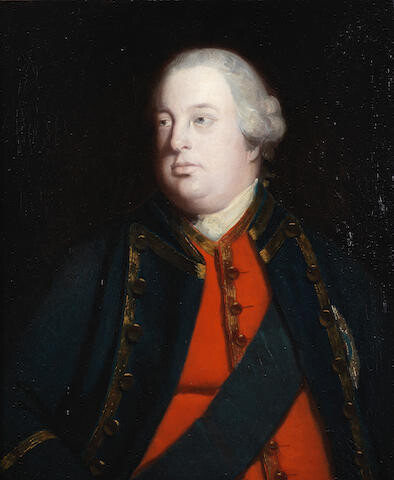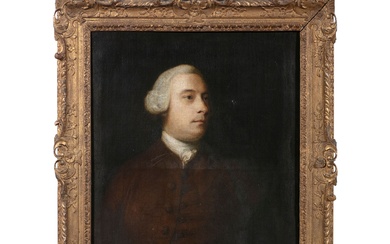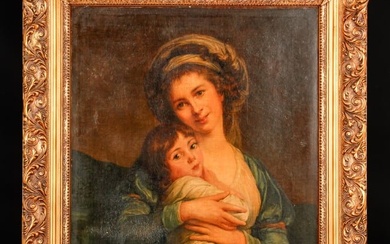Sir Joshua Reynolds, (Plympton 1723-1792 Richmond)
Portrait of Prince William Augustus, Duke of Cumberland, bust-length
Portrait of Prince William Augustus, Duke of Cumberland, bust-length
oil on canvas
78.4 x 63.8cm (30 7/8 x 25 1/8in).
Provenance
Collection of Edward Windeatt (1846-1921)
Collection of Mrs H R Cummings
Her sale, Christie's, London, 23 May 1930, lot 124
With Frost and Reed, London (purchased at the above sale)
Private Collection, San Francisco, until 2014
Private Collection, UK
The second eldest surviving son of King George II and Queen Caroline, William Augustus was always more favoured by his father than his estranged elder brother, Frederick Prince of Wales. His successful military career effectively began when he accompanied his father in 1743 at the Battle of Dettingen, but he is best remembered for his victories over the French in 1745 at Fontenay and most notably over the Jacobite army of Prince Charles Edward Stuart at Culloden the following year. This famous event in British history took place the day after the Duke's 25th Birthday. His treatment of the defeated Jacobites, including numerous civilians in the months that followed the battle on Drumossie Moor earned him the title 'Butcher Cumberland'; while on his return to London at the end of July he received a hero's welcome. Parliament had already voted thanks for the victory at Culloden and passed an act granting him and his heir £25,000 a year over and above his civil list grant. A thanksgiving service was held in Saint Paul's Cathedral at which was played the first performance of Handel's The Conquering Hero, composed specially for the King's son.
Following a brief campaign on the Continent which culminated in the Treaty of Aix-la-Chapelle in October, when he returned to England Cumberland spent most of his time in Windsor Forest, of which he had been made Ranger that same year. He lived mainly at the Ranger's Lodge, now known by his name, and employed hundreds of demobilized soldiers to construct the lake which became known as Virginia Water, and to plant trees, many of which still survive. His political career in the House of Lords was marked most notably by his rivalry with his elder brother until Frederick's death in 1751. Between 1754-60 he returned to military campaigning, assisting Frederick the Great of Prussia in what became known as the Seven Years War. After he signed what amounted to a capitulation at Kloster-Zeven in September 1757 he was dismissed by his father. After his return to London in October his reception was very different from that which he had received as the victor of Culloden twelve years earlier, when honours and rewards had been showered on him. After suffering a stroke in August 1760, although he recovered his powers of speech, he was thereafter incapacitated from the prospect of any further military activity even if he had still been in command. Reconciled to his nephew, Frederick's son the young George III when he came to the throne, Cumberland stood in as father of the bride when the King married Charlotte of Mecklenburg-Strelitz in 1761.
Cumberland's death in 1765 at the age of forty-four left an ambiguous legacy. On the one hand he was vilified as the 'Butcher', and there is a legend that he was also known as 'Stinking Billy' in Scotland, in retaliation against those of his admirers in England who adopted the flower Sweet William as his emblem. His complex reputation is further illustrated by the fact that when the Sons of Liberty in South Carolina drank forty-five healths in honour of John Wilkes, one of the toasts was 'to the Duke of Cumberland', who was regarded as a 'friend of America', having presided over the appointment of Lord Rockingham's ministry, which had repealed the Stamp Act.
We are grateful to Martin Postle for confirming the authenticity of this newly-discovered portrait which he believes is another version of the portrait of Cumberland published by Mannings as number 1892 in his monograph (see D. Mannings, Sir Joshua Reynolds: A Complete Catalogue of His Paintings) (NPG 625). It relates to the Spooner engraving of circa 1758-61 (NPG D3906) which because of the blue coat must have been made after this version rather than after 1893 in Mannings's book.
View it on
Sale price
Estimate
Time, Location
Auction House
Portrait of Prince William Augustus, Duke of Cumberland, bust-length
Portrait of Prince William Augustus, Duke of Cumberland, bust-length
oil on canvas
78.4 x 63.8cm (30 7/8 x 25 1/8in).
Provenance
Collection of Edward Windeatt (1846-1921)
Collection of Mrs H R Cummings
Her sale, Christie's, London, 23 May 1930, lot 124
With Frost and Reed, London (purchased at the above sale)
Private Collection, San Francisco, until 2014
Private Collection, UK
The second eldest surviving son of King George II and Queen Caroline, William Augustus was always more favoured by his father than his estranged elder brother, Frederick Prince of Wales. His successful military career effectively began when he accompanied his father in 1743 at the Battle of Dettingen, but he is best remembered for his victories over the French in 1745 at Fontenay and most notably over the Jacobite army of Prince Charles Edward Stuart at Culloden the following year. This famous event in British history took place the day after the Duke's 25th Birthday. His treatment of the defeated Jacobites, including numerous civilians in the months that followed the battle on Drumossie Moor earned him the title 'Butcher Cumberland'; while on his return to London at the end of July he received a hero's welcome. Parliament had already voted thanks for the victory at Culloden and passed an act granting him and his heir £25,000 a year over and above his civil list grant. A thanksgiving service was held in Saint Paul's Cathedral at which was played the first performance of Handel's The Conquering Hero, composed specially for the King's son.
Following a brief campaign on the Continent which culminated in the Treaty of Aix-la-Chapelle in October, when he returned to England Cumberland spent most of his time in Windsor Forest, of which he had been made Ranger that same year. He lived mainly at the Ranger's Lodge, now known by his name, and employed hundreds of demobilized soldiers to construct the lake which became known as Virginia Water, and to plant trees, many of which still survive. His political career in the House of Lords was marked most notably by his rivalry with his elder brother until Frederick's death in 1751. Between 1754-60 he returned to military campaigning, assisting Frederick the Great of Prussia in what became known as the Seven Years War. After he signed what amounted to a capitulation at Kloster-Zeven in September 1757 he was dismissed by his father. After his return to London in October his reception was very different from that which he had received as the victor of Culloden twelve years earlier, when honours and rewards had been showered on him. After suffering a stroke in August 1760, although he recovered his powers of speech, he was thereafter incapacitated from the prospect of any further military activity even if he had still been in command. Reconciled to his nephew, Frederick's son the young George III when he came to the throne, Cumberland stood in as father of the bride when the King married Charlotte of Mecklenburg-Strelitz in 1761.
Cumberland's death in 1765 at the age of forty-four left an ambiguous legacy. On the one hand he was vilified as the 'Butcher', and there is a legend that he was also known as 'Stinking Billy' in Scotland, in retaliation against those of his admirers in England who adopted the flower Sweet William as his emblem. His complex reputation is further illustrated by the fact that when the Sons of Liberty in South Carolina drank forty-five healths in honour of John Wilkes, one of the toasts was 'to the Duke of Cumberland', who was regarded as a 'friend of America', having presided over the appointment of Lord Rockingham's ministry, which had repealed the Stamp Act.
We are grateful to Martin Postle for confirming the authenticity of this newly-discovered portrait which he believes is another version of the portrait of Cumberland published by Mannings as number 1892 in his monograph (see D. Mannings, Sir Joshua Reynolds: A Complete Catalogue of His Paintings) (NPG 625). It relates to the Spooner engraving of circa 1758-61 (NPG D3906) which because of the blue coat must have been made after this version rather than after 1893 in Mannings's book.







